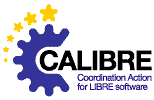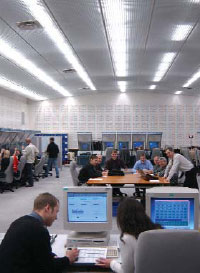ABSTRACTS
Experience Report
on www.OpenATC.org and AudioLan
by Gilles Gawinowski, EUROCONTROL
Abstract. AudioLAN & OpenATC represents several OSS initiatives. Lessons learnt seems to de-monstrate that the condition and interest to support this approach are not met:
- ATM research mass is to small.
- The process to transfer research into product and the customer-oriented approach are not adequat with an OSS approach.
- The core-business re-focus and outsourcing management decreased drastically software activities.
- Not a driver to resolve ATM research issues.
White Box approach
for a Trajectory Prediction Tool
by Carlos Garcia Avello and Sip Swierstra, EUROCONTROL
Abstract. Many critical and costly elements in the ATM system development process could well be shared without affecting the technical excellence of individual industries and their competitive advantages. A community approach to the development, validation and verification of such common elements is the most efficient way forward. The process of white boxing a TP aims at making it and the know-how that has been applied and accumulated during the development easily accessible to the ATM community. Due to these constraints the TP distribution will not be suitable for operational real-time applications. However, as the product will be provided as OS Software, any of its components could be used within existing applications. Behind the objective of providing the TP users with the possibility to analyze the insides and decide on the trade offs to be accepted, the provision of a WB TP aims at paving the way to the development of OSS widely used TP components. This will ensure the interoperability across ground TP clients and will enable the synchronisation of airborne and ground TPs.
Most important point for the future of OSS in ATM. Probably the most important benefit of OS in ATM is the possibility to use that vector for ensuring ATM systems interoperability. The TP being one of the underlying key functions of the future Trajectory Based ATM concept, providing OS TP elements, will facilitate systems interoperability and air and ground trajectory consistency.
Revisiting CHIPS as an Open Source Project
by Jean-Dominique Frayssinoux, ATM consultant
Abstract. First part of this presentation gives objectives and advantages of Open Source Software in ATM environment. Second part of this presentation describes an Open Source Software in the near future: CHIPS program. This software is a tool that provides assistance to the controllers to enable efficient resolution of conflicts between aircrafts.
Most important point for the future of OSS in ATM. Open Source Software is a good opportunity to present useful softwares and to show ATM expertise. Distributing Open Source Software on a web site provides useful contacts with ATM organisations and ATM companies in the whole word.
COTS, FLOSS, and Market Freedom
in Safety-Centric Industries
by Franco Gasperoni, Adacore, Inc
Abstract. This presentation discusses the relationship between commercial off-the-shelf software (COTS) and freely licensed open source software (FLOSS) from a purely business perspective. The emphasis is on safety-centric industries such as aerospace (the full executive summary is at the beginning of the paper).
Most important point for the future of OSS in ATM. Our works shows that all other things being equal a freely licensed COTS is always better, for the customer, than a restrictively licensed COTS because the lack of vendor lock-in for software changes, support, and certification material aligns the COTS vendor interests with the customerís around high-quality products and services at competitive prices. Put it another way, to the question: Should the ATM industry lobby with its vendor(s) so that, when it is of value, the vendor(s) make their COTS available to them with a FLOSS-like license? The answer is a resounding yes.
OSS and IPR Evolution in Eurocontrol
by Burkhart von Erlach, EUROCONTROL
Abstract. Open source software is fairly new to ATM and EUROCONTROL. This presentation expands on some terms which are linked to some extent to open source software. It further explains the current policy of EUROCONTROL and highlights why EUROCONTROL as an international organisation needs to be cautious and is not as free as industry. OSS has not really taken up in ATM so far for various reasons. The author mentions a few of them and also lists a few conditions under which OSS might become more successful in ATM and wonders if this could not be an activity for EUROCONTROL.
Permissive vs Restrictive OSS Licences
by Delphine Prieur, INRIA
Abstract. The legal aspects of protecting software include moral rights and economic rights. A license is a contract that confers more or less rights to licensees. It is a regulation tool. Copyleft is not the antithesis of copyright. Counterfeiting is the violation of at least one of the rights attributed to a software. Three major licenses are shortly presented: GPL, CeCILL and NewBSB. It is important to point out that the legal framework has not yet been tested and that there are compatibility problems between OSS licenses.
Most important point for the future of OSS in ATM. To choose a license, the question is not to consider whether it is permissive or not, but to ask relevant questions about the intentions for the developments (who will make the developments? what will be the status of the contributions?), and for the distribution (to whom and why?), keeping in mind that your intentions may change: it is better to use a flexible model.
Working with OSS Licences in PHILIPS
by Arnoud Engelfriet, PHILIPS
Abstract. Philips Electronics has used combinations of open source and closed, proprietary software for several years. This presents various challenges, such as how to safely combine the two, how to handle open source distribution requirements, and other things. Engelfriet will use Philips' ABISS hard-disk scheduler (http://abiss.sourceforge.net/), which Philips contributed to the Linux kernel, as a case study to show best practices for managing mixed-IP product development. For various reasons, Philips wanted to keep certain parts of ABISS closed, and so the company developed a methodology to evaluate where this would be most appropriate and how this would be possible.
TCAS being Open Source
before the term was coined
by Garfield Dean, EUROCONTROL
Abstract. This presentation draws an analogy between the development of the TCAS (Traffic-alert and Collision Avoidance System) algorithms, and OSS. First, the TCAS system is very briefly described. Next a brief history of the development of the system is provided. In particular, it describes the roles played by two standardization bodies: the International Civil Aviation Authority (ICAO) and the Radio Technical Commission for Aeronautics (RTCA). In the main body of the presentation, the development of TCAS and OSS are compared and contrasted. Finally, the author speculates about where OSS might or might not be applied in Air Traffic Management (ATM).
Most important points for the future of OSS in ATM.
- a) Who will be responsible for any OSS development in ATM, especially when there is an accident like Uberlingen?
- b) A related issue is whether we can trust OSS for safety critical systems. There is a risk of creating something that wants to be all things to all men (safe in all circumstances), but satisfies no-none (because it is unusably combersome).
Quality Improvement and Release Management
by Martin Michlmayr, University of Cambridge
Abstract. It is sometimes argued that free software and open source projects are generally of higher quality than proprietary software. While there is good evidence that high amounts of peer review contribute to quality, there are also a large number of issues which have to be addressed. Development in free software projects is carried out in a distributed fashion and commonly performed by volunteers, which leads to unique challenges that have to be faced. This presentation will give an overview of common quality issues found in both large and small free software projects and then focus on release management, one problematic area in many free software projects.
OSS in Secondary Software Sector,
Voice of Industry
by John O' Flaherty, CALIBRE
Abstract. This presentation addresses the open source software (OSS) phenomenon from an industry perspective and reveals a number of complexities surrounding the role of OSS in the secondary software sector. It presents the research results of an international workshop which was hosted with the explicit intention of extracting the voice of key industrial stakeholders. The data was gathered and analysed using a qualitative approach which revealed the key strengths and weaknesses of OSS from an industrial perspective. This formed the foundations for developing a framework describing the emerging commercial incarnation of OSS (we refer to this as Open Source Software, Inc.) The paper concludes that the European secondary software sector recognise the benefits of leveraging OSS but are aware of key issues pertinent to such an end.




